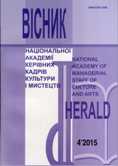ДО МЕТОДИКИ ПІДГОТОВКИ ВИКОНАВЦІВ БАЛЬНОГО ТАНЦЮ
Regarding the methods of the preparation of the ballroom dancing performers
Author(s): Maryna BogdanovaSubject(s): Theatre, Dance, Performing Arts, Music, Cultural Anthropology / Ethnology, Theory of Communication, Higher Education
Published by: Національна академія керівних кадрів культури і мистецтв
Keywords: culture; performing culture; ballroom dance; technique; methods; expressiveness; dancing style;
Summary/Abstract: The article considers the specifics of the classical method of the forming of the technique and performing culture of the ballroom dancers, aimed at improving the technical side of dance, developing strength and flexibility, softness and accuracy of the movements, the development of the expressiveness, dancing style of the students. An important mechanism to enrich the ball choreography is the relationship of the classical and folk dance as the basis for the preparation of ballroom dancers.The style and manner of the performing of the ballroom dance, which traditionally developed in the course of their implementation, combine these essential features for the mass perception as the relative simplicity, generosity and optimism. The ballroom dancing have the elegance and sophistication to emphasize the lines of the manners. This is evident in the performing style and the character of the dance image. The range of the performance techniques in the ballroom choreography is immensely wide. The above-mentioned things allow the choreographer to create a lot of dance tracks, just as the composer based on a certain scale can build the appropriate height sound connections. The wealth of the expression means makes for a choreographer the possibility to create the colorful dance forms. The training work should be realized by the teacher-choreographer with the orientation for the development of the creative potential of the dancing couple and its artistic abilities. Each lesson the teacher should start with the targeting of the dancers for the individual interpretation of the choreographic image, because this method will contribute to the high efficiency of the realization of the creative self-improvement.At the beginning of the twentieth century the typical styles and trends for European countries, were rooted on the basis of the Ukrainian culture. It perceived the modern and avant-garde artistic movements. The theoreticians of the modern choreography in the Ukraine were increasingly turning to the functioning of the unregulated artistic forms of the ballroom dance. The most common stereotypes of the modern and impressionist dance, dance forms, accompanied by the music of jazz and rock were in the studies of a number of the authors.The knowledge of the dance culture was considered as the integral part of the general culture of the XIXth century. In the second half of the XIXth century the Russian choreographers staged the new salon dancing, appealing to the stylistic features of the classical ballet choreography. Thus it was created the waltz mignon, Chacón and padekatr (N. Gavlikovsky), padegras (E. Ivanov), pas de trois (A. Bychkov). These leading ballet dancers of the Imperial Theatres were both professors point choreographer in the secular educational institutions and aristocratic salons, and published the corresponding methodical manuals.The art culture of Ukraine, which territory in the XIX century belonged to the Russian and Austro-Hungarian Empires, has not lost the features of the national identity and functioned in the variety of the forms of the official and public thoughts, clubs and literary evenings and parties, carnivals, calendar and family celebrations, folk festivals for the urban population, fairs and etc.In this period the representatives of the intellectuals in their childhood specifically attached to the art of the ball-room dancing. The choreography was an obligatory subject in the private boarding schools, gymnasiums, lyceums, military and commercial schools, Institutes for Noble Maidens, the Corps of Pages, and so on.The special attention was paid to the art of the choreography in the Institutes for Noble Maidens. In particular, the official patroness of the Kiev Institute was Russian Empress. The schoolgirl prepared to these visits a special dance program with the elements of the ballroom dancing and choreographic miniatures, which were performed at the high artistic level, because the choreography was taught by the well-known choreographers from the other countries too. The classical technique is considered to be a powerful guarantee and the only possible basis for the success of any comprehensive dance as a scenic and household. The classical dance and classical exercise are the foundation which forms the entire basis of the choreographic art. The technical accuracy allows the dancer not only to find the required plasticity of the movement, his/her expressive phrasing, the confidence in their abilities, but also a creative interpretation of the physical activity. The delicately worked out dance technique makes the art. And no highly artistic idea and play of the choreographic exciting plot can not replace the respect for the accuracy in the realization of a dancer performing techniques.
Journal: Вісник Національної академії керівних кадрів культури і мистецтв
- Issue Year: 2015
- Issue No: 4
- Page Range: 65-69
- Page Count: 5
- Language: Ukrainian

